Analysis of Diffusion Characteristics and Influencing Factors of Particulate Matter in Ship Exhaust Plume in Arctic Environment Based on CFD
Abstract
:1. Introduction
2. Numerical Calculation Method
2.1. CFD Mathematical Model Establishment
2.2. Parameter Definition of the Diffusion Effect of Ship Exhaust Particulate Matter
2.2.1. Yaw Angle and Synthetic Wind Speed
2.2.2. Chimney Angle
2.3. Computational Model and Mesh Division
2.4. Mesh Independence Verification
2.5. Boundary Conditions and Parameters Determination
2.6. CFD Mathematical Model Verification
3. Simulation Results and Analysis
3.1. Diffusion Law of Particulate Matter in Ship Exhausts
3.2. Analysis of the Influence of Synthetic Wind Speed on the Diffusion of Particulate Matter from Ship Exhaust
3.3. Analysis of the Influence of Yaw Angle on the Diffusion of Particulate from Ship Exhaust
3.4. Analysis of the Influence of Chimney Angle on the Diffusion of Particulate from Ship Exhaust
4. Conclusions
Author Contributions
Funding
Institutional Review Board Statement
Informed Consent Statement
Data Availability Statement
Conflicts of Interest
References
- Aliabadi, A.A.; Staebler, R.M.; Sharma, S. Air quality monitoring in communities of the Canadian Arctic during the high shipping season with a focus on local and marine pollution. Atmos. Chem. Phys. 2015, 15, 2651–2673. [Google Scholar] [CrossRef]
- Simmonds, I.; Li, M. Trends and variability in polar sea ice, global atmospheric circulations, and baroclinicity. Ann. N. Y. Acad. Sci. 2021, 1504, 167–186. [Google Scholar] [CrossRef] [PubMed]
- Simmonds, I.; Keay, K. Extraordinary September Arctic sea ice reductions and their relationships with storm behavior over 1979–2008. Geophys. Res. Lett. 2009, 36, L19715. [Google Scholar] [CrossRef]
- Chen, J.; Kang, S.; Chen, C.; You, Q.; Du, W.; Xu, M.; Zhong, X.; Zhang, W.; Chen, J. Changes in sea ice and future accessibility along the Arctic Northeast Passage. Glob. Planet. Change 2020, 195, 103319. [Google Scholar] [CrossRef]
- Wei, T.; Yan, Q.; Qi, W.; Ding, M.; Wang, C. Projections of Arctic sea ice conditions and shipping routes in the twenty-first century using CMIP6 forcing scenarios. Environ. Res. Lett. 2020, 15, 104079. [Google Scholar] [CrossRef]
- Li, X.; Stephenson, S.R.; Lynch, A.H.; Goldstein, M.A.; Bailey, D.A.; Veland, S. Arctic shipping guidance from the CMIP6 ensemble on operational and infrastructural timescales. Clim. Change 2021, 167, 23. [Google Scholar] [CrossRef]
- Roiger, A.; Thomas, J.-L.; Schlager, H.; Law, K.S.; Kim, J.; Schäfler, A.; Weinzierl, B.; Dahlkötter, F.; Krisch, I.; Marelle, L.; et al. Quantifying emerging local anthropogenic emissions in the Arctic region: The ACCESS aircraft campaign experiment. Bull. Am. Meteorol. Soc. 2015, 96, 441–460. [Google Scholar] [CrossRef]
- Moldanová, J.; Fridell, E.; Winnes, H.; Holmin-Fridell, S.; Boman, J.; Jedynska, A.; Tishkova, V.; Demirdjian, B.; Joulie, S.; Bladt, H.; et al. Physical and chemical characterisation of PM emissions from two ships operating in European Emission Control Areas. Atmos. Meas. Tech. 2013, 6, 3577–3596. [Google Scholar] [CrossRef]
- Oeder, S.; Kanashova, T.; Sippula, O.; Sapcariu, S.C.; Streibel, T.; Arteaga-Salas, J.M.; Passig, J.; Dilger, M.; Paur, H.-R.; Schlager, C.; et al. Particulate matter from both heavy fuel oil and diesel fuel shipping emissions show strong biological effects on human lung cells at realistic and comparable in vitro exposure conditions. PLoS ONE 2015, 10, e0126536. [Google Scholar] [CrossRef] [PubMed]
- Corbin, J.C.; Peng, W.; Yang, J.; Sommer, D.E.; Trivanovic, U.; Kirchen, P.; Miller, J.W.; Rogak, S.; Cocker, D.R.; Smallwood, G.J.; et al. Characterization of particulate matter emitted by a marine engine operated with liquefied natural gas and diesel fuels. Atmos. Environ. 2020, 220, 117030. [Google Scholar] [CrossRef]
- Gao, Y.; Ji, H. Microscopic morphology and seasonal variation of health effect arising from heavy metals in PM2.5 and PM10: One-year measurement in a densely populated area of urban Beijing. Atmos. Res. 2018, 212, 213–226. [Google Scholar] [CrossRef]
- Corbett, J.J.; Winebrake, J.J.; Green, E.H.; Kasibhatla, P.; Eyring, V.; Lauer, A. Mortality from ship emissions: A global assessment. Environ. Sci. Technol. 2007, 41, 8512–8518. [Google Scholar] [CrossRef] [PubMed]
- Lauer, A.; Eyring, V.; Hendricks, J.; Jöckel, P.; Lohmann, U. Global model simulations of the impact of ocean-going ships on aerosols, clouds, and the radiation budget. Atmos. Chem. Phys. 2007, 7, 5061–5079. [Google Scholar] [CrossRef]
- Streibel, T.; Schnelle-Kreis, J.; Czech, H.; Harndorf, H.; Jakobi, G.; Jokiniemi, J.; Karg, E.; Lintelmann, J.; Matuschek, G.; Michalke, B.; et al. Aerosol emissions of a ship diesel engine operated with diesel fuel or heavy fuel oil. Environ. Sci. Pollut. Res. 2017, 24, 10976–10991. [Google Scholar] [CrossRef]
- Eyring, V.; Isaksen, I.S.; Berntsen, T.; Collins, W.J.; Corbett, J.J.; Endresen, O.; Grainger, R.G.; Moldanova, J.; Schlager, H.; Stevenson, D.S. Transport impacts on atmosphere and climate: Shipping. Atmos. Environ. 2010, 44, 4735–4771. [Google Scholar] [CrossRef]
- Agrawal, H.; Welch, W.A.; Miller, J.W.; Cocker, D.R. Emission measurements from a crude oil tanker at sea. Environ. Sci. Technol. 2008, 42, 7098–7103. [Google Scholar] [CrossRef]
- Petzold, A.; Hasselbach, J.; Lauer, P.; Baumann, R.; Franke, K.; Gurk, C.; Schlager, H.; Weingartner, E. Experimental studies on particle emissions from cruising ship, their characteristic properties, transformation and atmospheric lifetime in the marine boundary layer. Atmos. Chem. Phys. 2008, 8, 2387–2403. [Google Scholar] [CrossRef]
- Bond, T.C.; Doherty, S.J.; Fahey, D.W.; Forster, P.M.; Berntsen, T.; DeAngelo, B.J.; Flanner, M.G.; Ghan, S.; Kärcher, B.; Koch, D.; et al. Bounding the role of black carbon in the climate system: A scientific assessment. J. Geophys. Res. Atmos. 2013, 118, 5380–5552. [Google Scholar] [CrossRef]
- Law, K.S.; Stohl, A. Arctic air pollution: Origins and impacts. Science 2007, 315, 1537–1540. [Google Scholar] [CrossRef]
- Feng, Y.; Qu, J.; Wu, Y.; Zhu, Y.; Jing, H. Utilizing waste heat from natural gas engine and LNG cold energy to meet heat-electric-cold demands of carbon capture and storage for ship decarbonization: Design, optimization and 4E analysis. J. Clean. Prod. 2024, 446, 141359. [Google Scholar] [CrossRef]
- Ausmeel, S.; Eriksson, A.; Ahlberg, E.; Sporre, M.K.; Spanne, M.; Kristensson, A. Ship plumes in the Baltic Sea Sulfur Emission Control Area: Chemical characterization and contribution to coastal aerosol concentrations. Atmos. Chem. Phys. 2020, 20, 9135–9151. [Google Scholar] [CrossRef]
- Lack, D.A.; Corbett, J.J.; Onasch, T.; Lerner, B.; Massoli, P.; Quinn, P.K.; Bates, T.S.; Covert, D.S.; Coffman, D.; Sierau, B.; et al. Particulate emissions from commercial shipping: Chemical, physical, and optical properties. J. Geophys. Res. Atmos. 2009, 114, D00F04. [Google Scholar] [CrossRef]
- Cappa, C.D.; Williams, E.J.; Lack, D.A.; Buffaloe, G.M.; Coffman, D.; Hayden, K.L.; Herndon, S.C.; Lerner, B.M.; Li, S.-M.; Massoli, P.; et al. A case study into the measurement of ship emissions from plume intercepts of the NOAA ship Miller Freeman. Atmos. Chem. Phys. 2014, 14, 1337–1352. [Google Scholar] [CrossRef]
- Sinha, P.; Hobbs, P.V.; Yokelson, R.J.; Christian, T.J.; Kirchstetter, T.W.; Bruintjes, R. Emissions of trace gases and particles from two ships in the southern Atlantic Ocean. Atmos. Environ. 2003, 37, 2139–2148. [Google Scholar] [CrossRef]
- Shen, F.; Li, X. Effects of fuel types and fuel sulfur content on the characteristics of particulate emissions in marine low-speed diesel engine. Environ. Sci. Pollut. Res. 2020, 27, 37229–37236. [Google Scholar] [CrossRef]
- Zetterdahl, M.; Moldanova, J.; Pei, X.; Pathak, R.K.; Demirdjian, B. Impact of the 0.1% fuel sulfur content limit in SECA on particle and gaseous emissions from marine vessels. Atmos. Environ. 2016, 145, 338–345. [Google Scholar] [CrossRef]
- Ausmeel, S.; Eriksson, A.; Ahlberg, E.; Kristensson, A. Methods for identifying aged ship plumes and estimating contribution to aerosol exposure downwind of shipping lanes. Atmos. Meas. Tech. 2019, 12, 4479–4493. [Google Scholar] [CrossRef]
- Petzold, A.; Weingartner, E.; Hasselbach, J.; Lauer, P.; Kurok, C.; Fleischer, F. Physical properties, chemical composition, and cloud forming potential of particulate emissions from a marine diesel engine at various load conditions. Environ. Sci. Technol. 2010, 44, 3800–3805. [Google Scholar] [CrossRef] [PubMed]
- Kulkarni, P.R.; Singh, S.N.; Seshadri, V. Flow Visualization Studies of Exhaust Smoke-Superstructure Interaction on Naval Ships. Nav. Eng. J. 2005, 117, 41–56. [Google Scholar] [CrossRef]
- Xu, Y.; Yu, Q.; Zhang, Y.; Ma, W. Numerical study on the plume behavior of multiple stacks of container ships. Atmosphere 2021, 12, 600. [Google Scholar] [CrossRef]
- Kim, J.H.; Park, S.M.; Cha, H.; Seol, S.S. Numerical research on establishing optimum design criterion of ship’s funnel. ASME Int. Mech. Eng. Congr. Expo. 2008, 48715, 213–219. [Google Scholar] [CrossRef]
- Zhou, F.; Zhu, L.; Zou, J.; Bai, X. Tracking and measuring plumes from sailing ships using an unmanned aerial vehicle. IET Intell. Transp. Syst. 2023, 17, 285–294. [Google Scholar] [CrossRef]
- Lee, W.J.; Jang, S.H.; Kim, S.Y.; Kang, M.K.; Chun, K.W.; Cho, K.H.; Yoon, S.-H.; Choi, J.-H. Experimental study on structure characteristics of particulate matter emitted from ship at various sampling conditions. J. Korean Soc. Mar. Environ. Saf. 2016, 22, 547–553. [Google Scholar] [CrossRef]
- Murphy, S.M.; Agrawal, H.; Sorooshian, A.; Padro, L.T.; Gates, H.; Hersey, S.; Welch, W.A.; Jung, H.; Miller, J.W.; Cocker, D.R.; et al. Comprehensive simultaneous shipboard and airborne characterization of exhaust from a modern container ship at sea. Environ. Sci. Technol. 2009, 43, 4626–4640. [Google Scholar] [CrossRef] [PubMed]
- Lack, D.A.; Corbett, J.J. Black carbon from ships: A review of the effects of ship speed, fuel quality and exhaust gas scrubbing. Atmos. Chem. Phys. 2012, 12, 3985–4000. [Google Scholar] [CrossRef]
- Aliabadi, A.A.; Thomas, J.L.; Herber, A.B.; Staebler, R.M.; Leaitch, W.R.; Schulz, H.; Law, K.S.; Marelle, L.; Burkart, J.; Willis, M.D.; et al. Ship emissions measurement in the Arctic by plume intercepts of the Canadian Coast Guard icebreaker Amundsen from the Polar 6 aircraft platform. Atmos. Chem. Phys. 2016, 16, 7899–7916. [Google Scholar] [CrossRef]
- Markiewicz, M. A review of mathematical models for the atmospheric dispersion of heavy gases. Part I. A classification of models. Ecol. Chem. Eng. S 2012, 19, 297–314. [Google Scholar] [CrossRef]
- Zhu, H.; Su, J.; Wei, X.; Han, Z.; Zhou, D.; Wang, X.; Bao, Y. Numerical simulation of haze-fog particle dispersion in the typical urban community by using discrete phase model. Atmosphere 2020, 11, 381. [Google Scholar] [CrossRef]
- El-Emam, M.A.; Zhou, L.; Yasser, E.; Bai, L.; Shi, W. Computational methods of erosion wear in centrifugal pump: A state-of-the-art review. Arch. Comput. Methods Eng. 2022, 29, 3789–3814. [Google Scholar] [CrossRef]
- Zhang, Y.; Yang, X.; Brown, R.; Yang, L.; Morawska, L.; Ristovski, Z.; Fu, Q.; Huang, C. Shipping emissions and their impacts on air quality in China. Sci. Total Environ. 2017, 581, 186–198. [Google Scholar] [CrossRef] [PubMed]
- Taylor, P.C.; Hegyi, B.M.; Boeke, R.C.; Boisvert, L.N. On the increasing importance of air-sea exchanges in a thawing Arctic: A review. Atmosphere 2018, 9, 41. [Google Scholar] [CrossRef]
- Rana, S.; Saxena, M.R.; Maurya, R.K. A review on morphology, nanostructure, chemical composition, and number concentration of diesel particulate emissions. Environ. Sci. Pollut. Res. 2022, 29, 15432–15489. [Google Scholar] [CrossRef]
- Moldanová, J.; Fridell, E.; Popovicheva, O.; Demirdjian, B.; Tishkova, V.; Faccinetto, A.; Focsa, C. Characterisation of particulate matter and gaseous emissions from a large ship diesel engine. Atmos. Environ. 2009, 43, 2632–2641. [Google Scholar] [CrossRef]
- Ergin, S.; Dobrucalı, E. Numerical modeling of exhaust smoke dispersion for a generic frigate and comparisons with experiments. J. Mar. Sci. Appl. 2014, 13, 206–211. [Google Scholar] [CrossRef]
- Kulkarni, P.R.; Singh, S.N.; Seshadri, V. Parametric studies of exhaust smoke–superstructure interaction on a naval ship using CFD. Comput. Fluids 2007, 36, 794–816. [Google Scholar] [CrossRef]
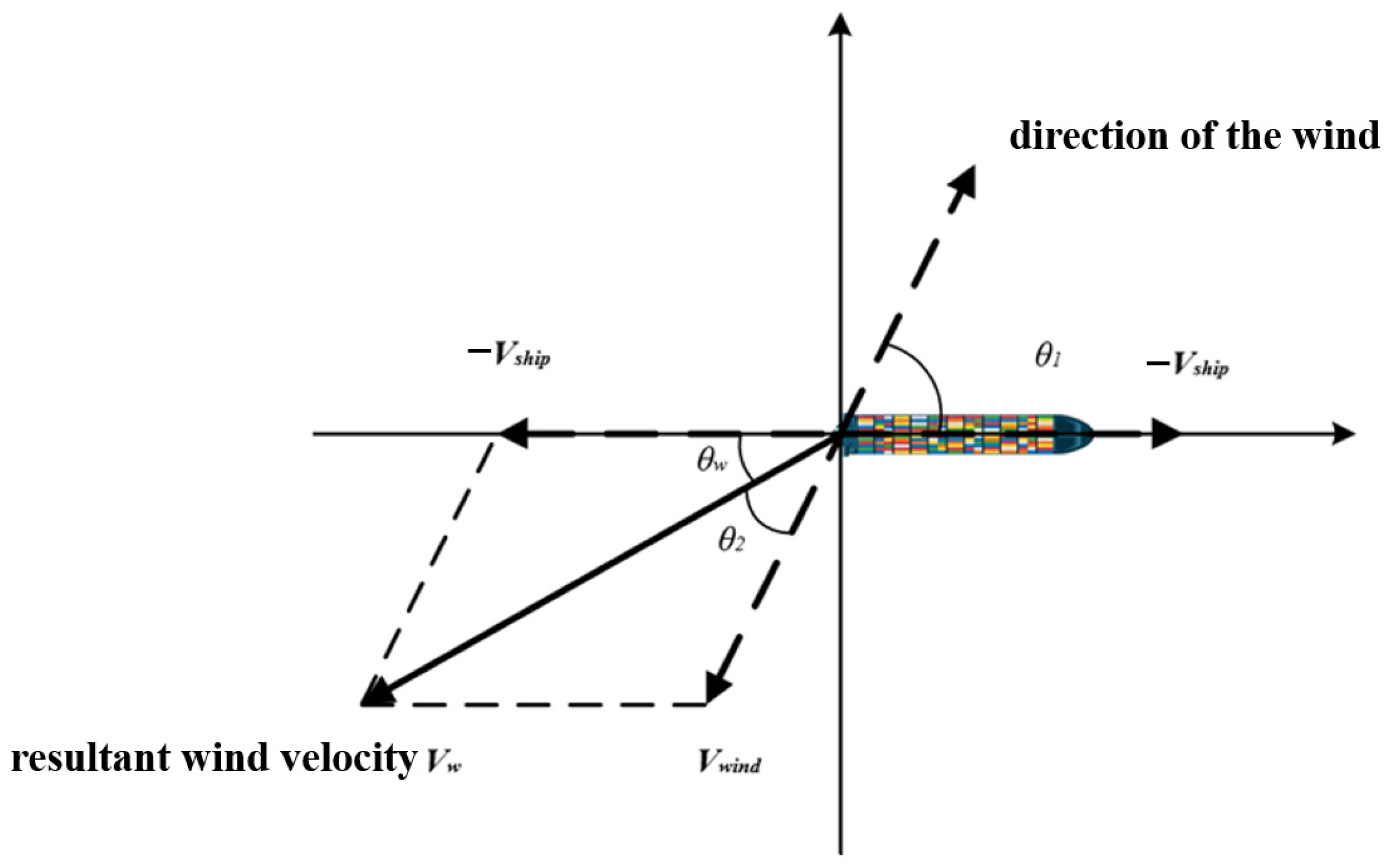
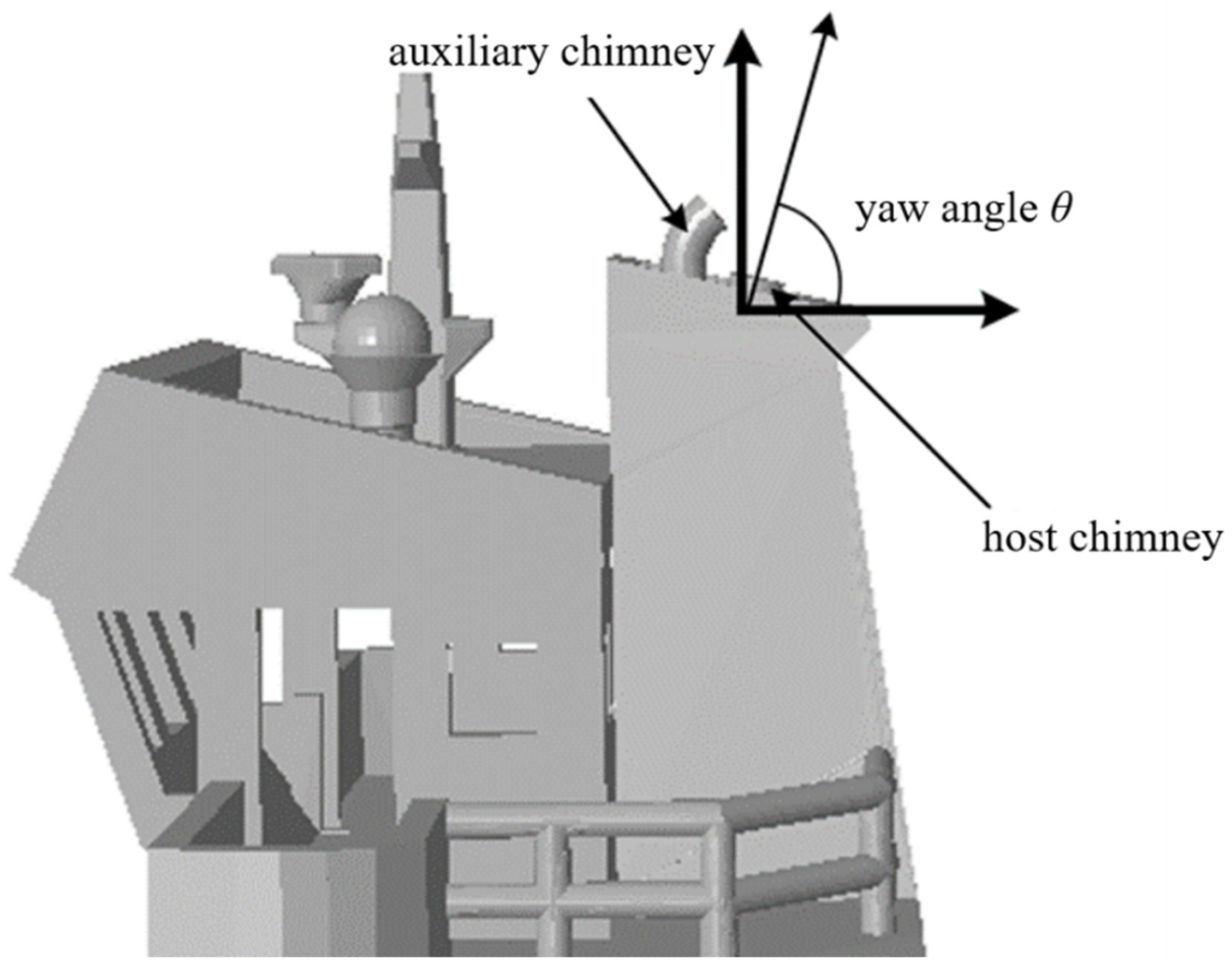
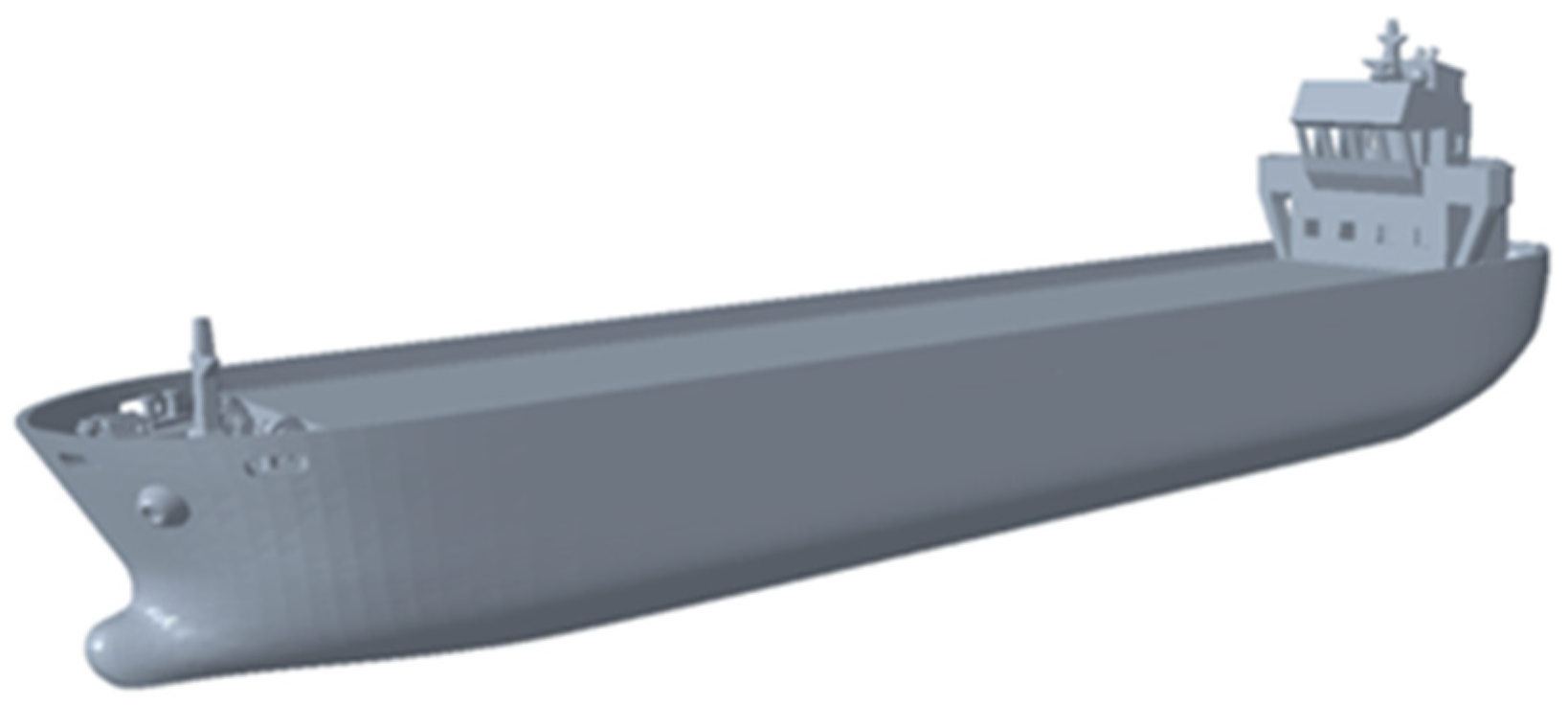
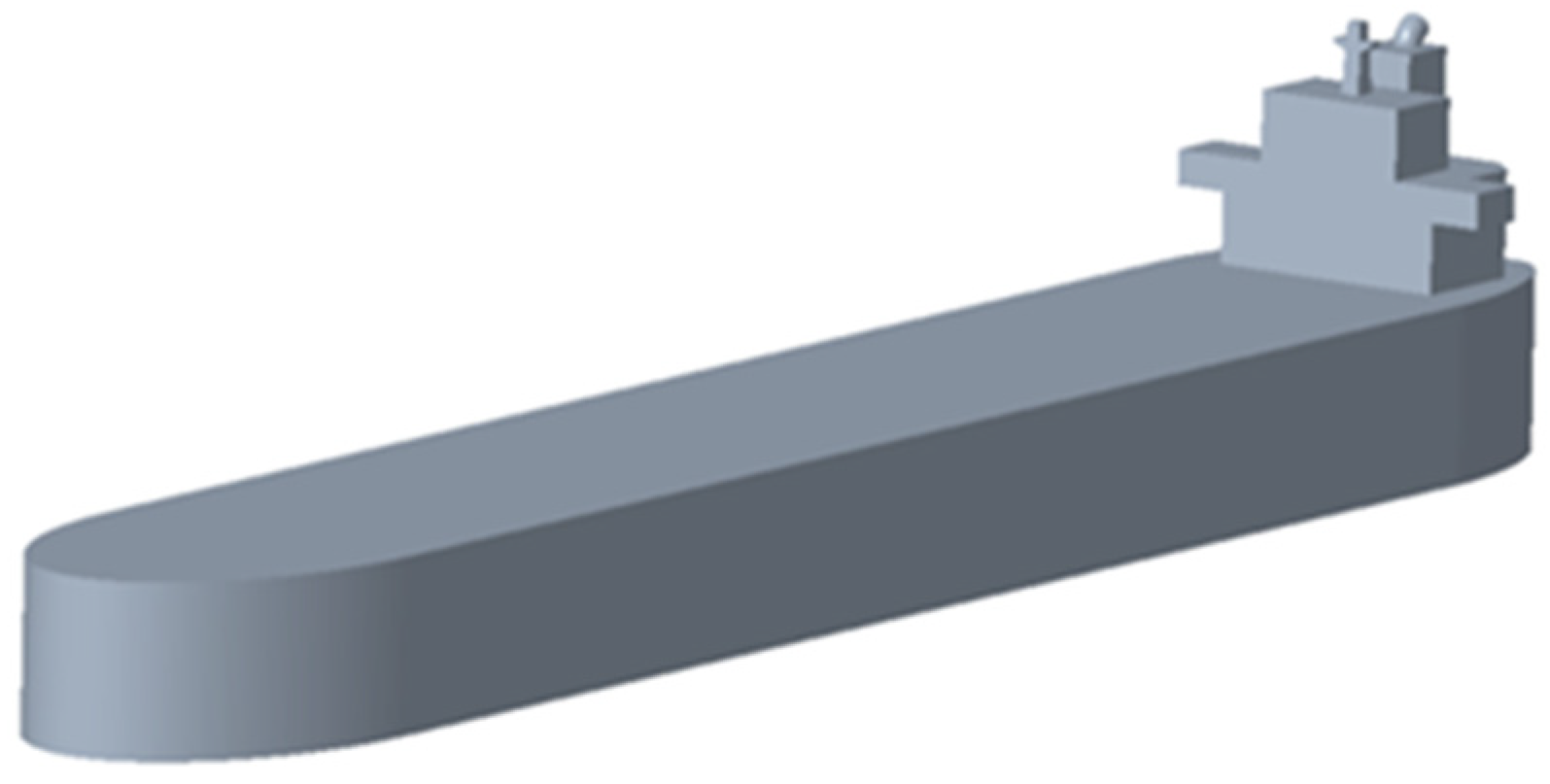
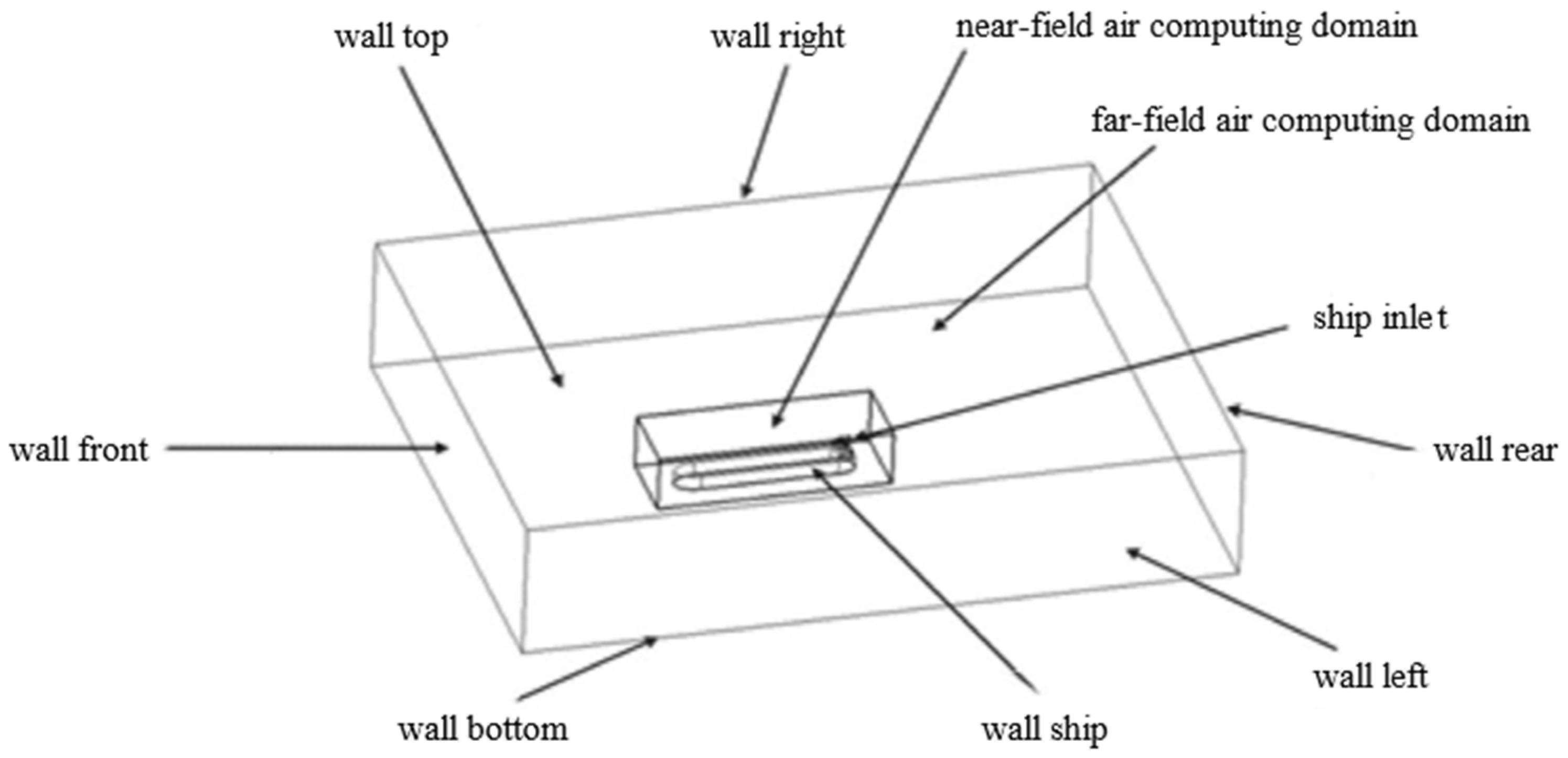
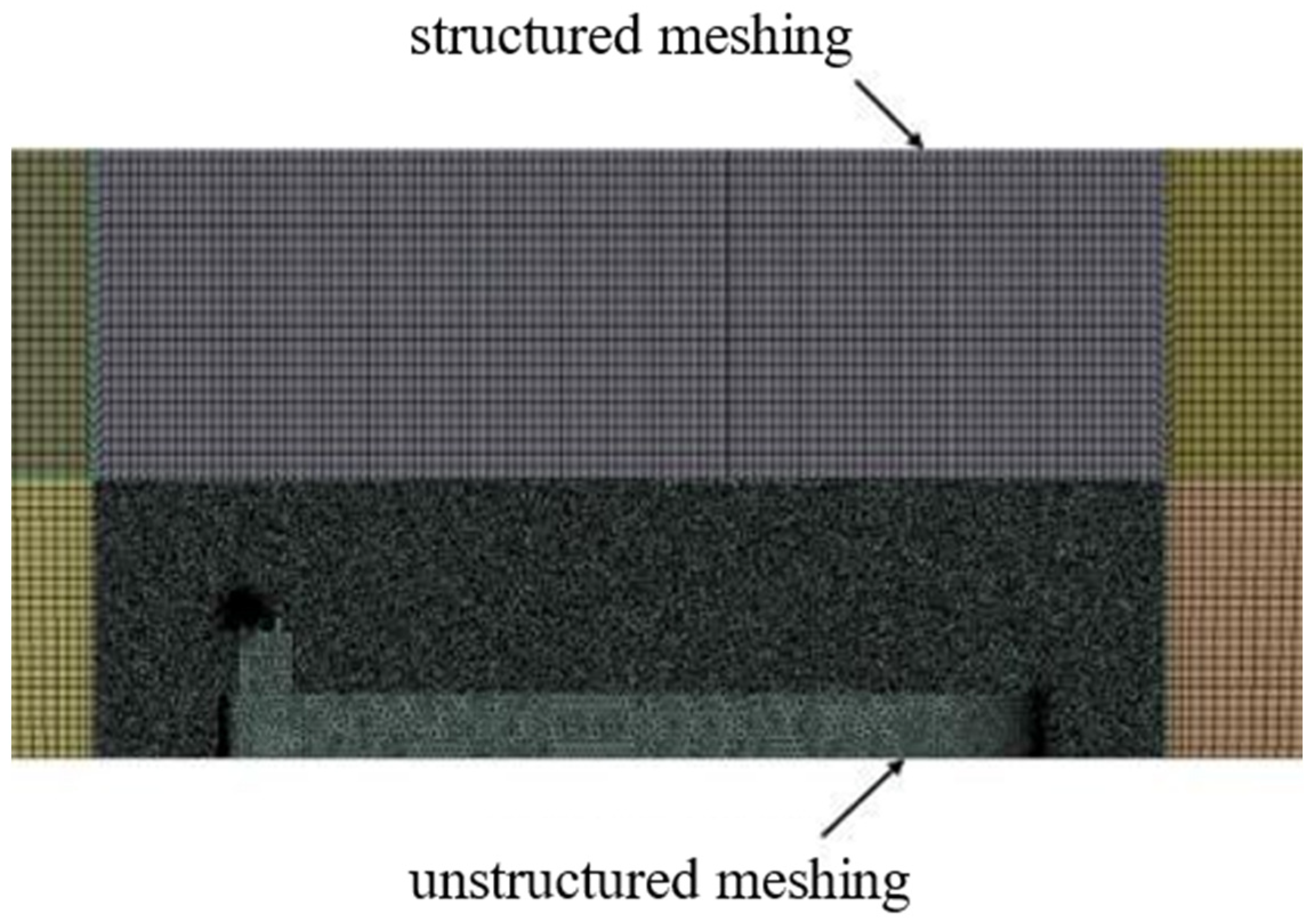
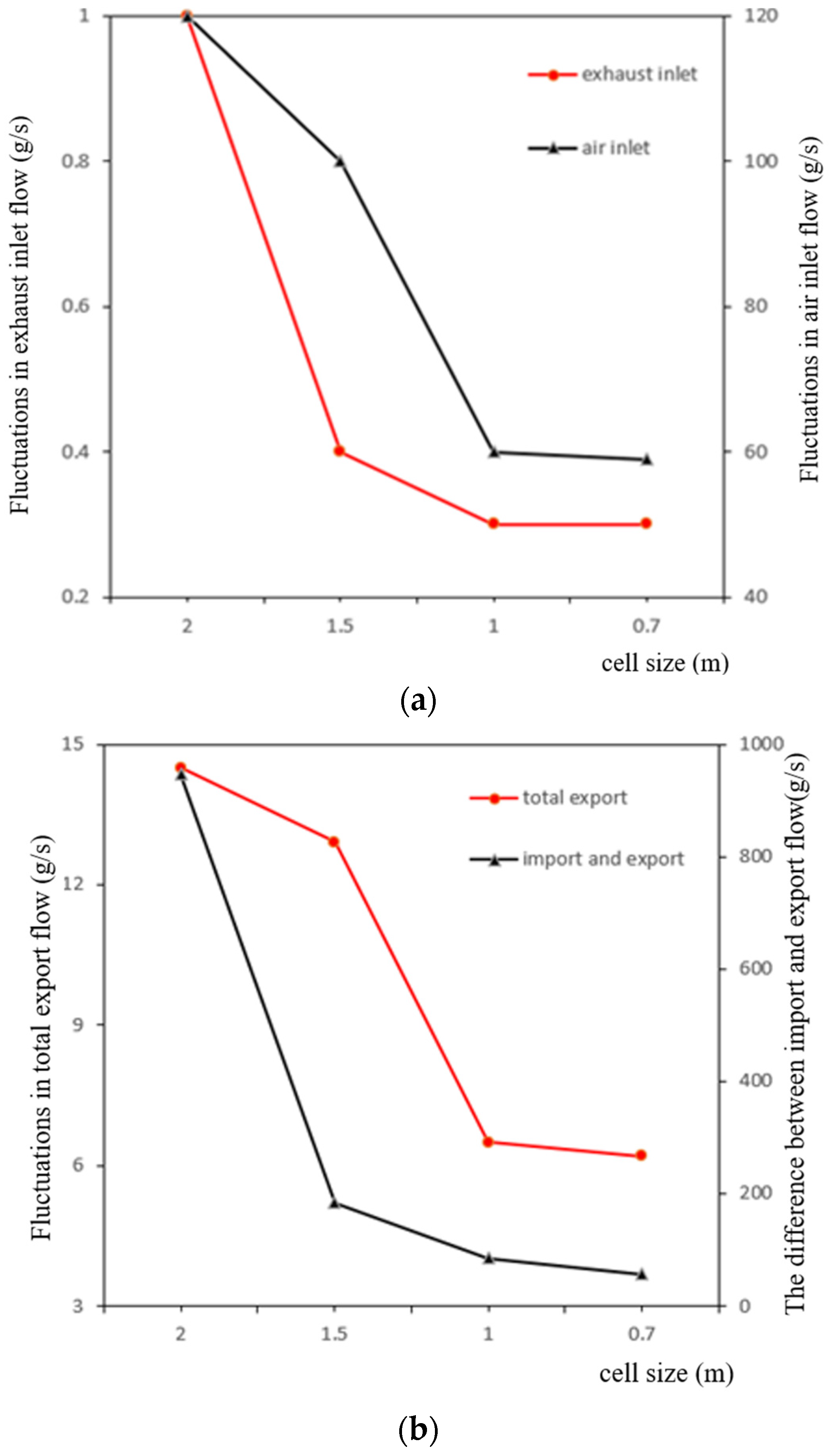


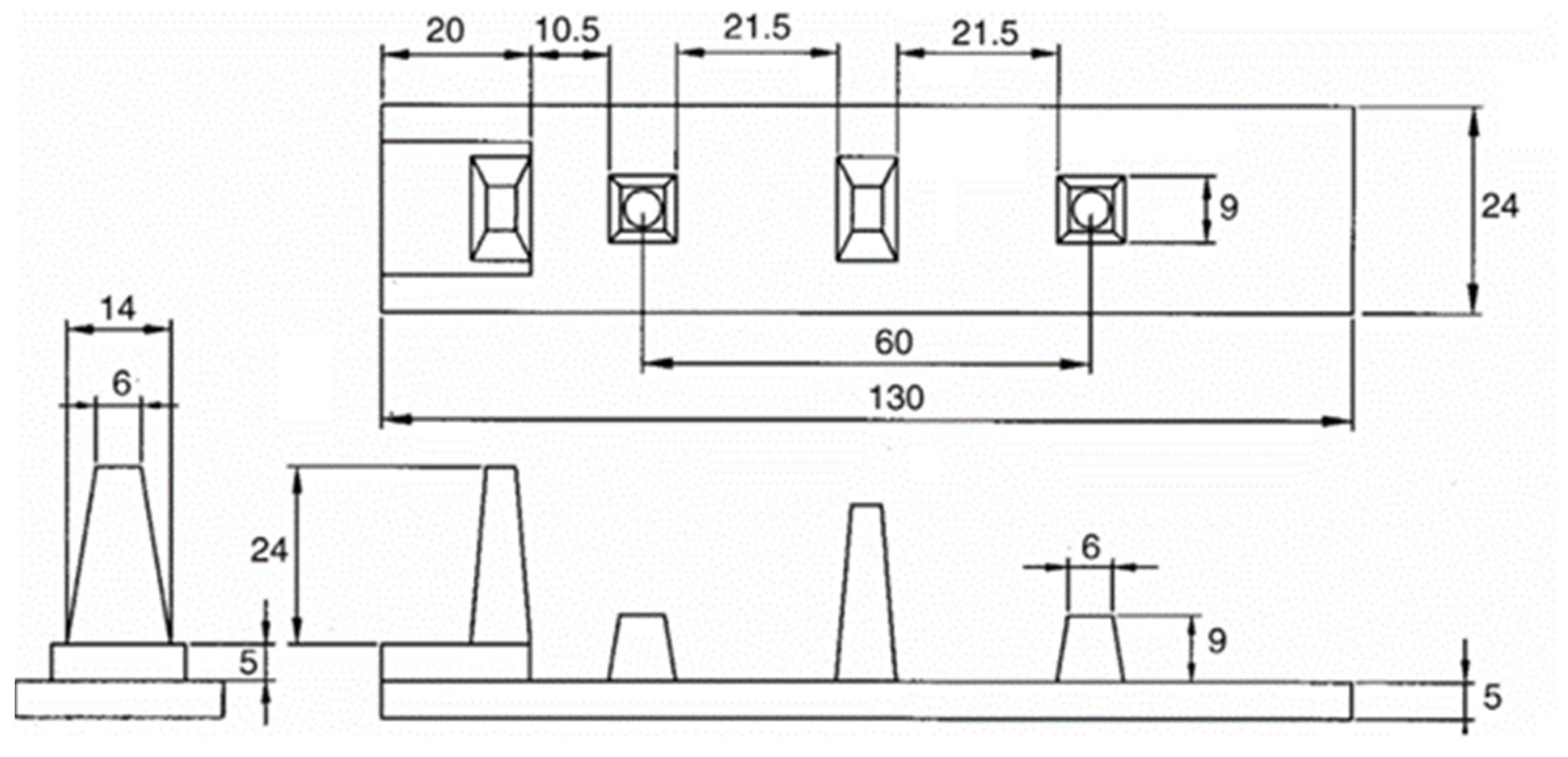
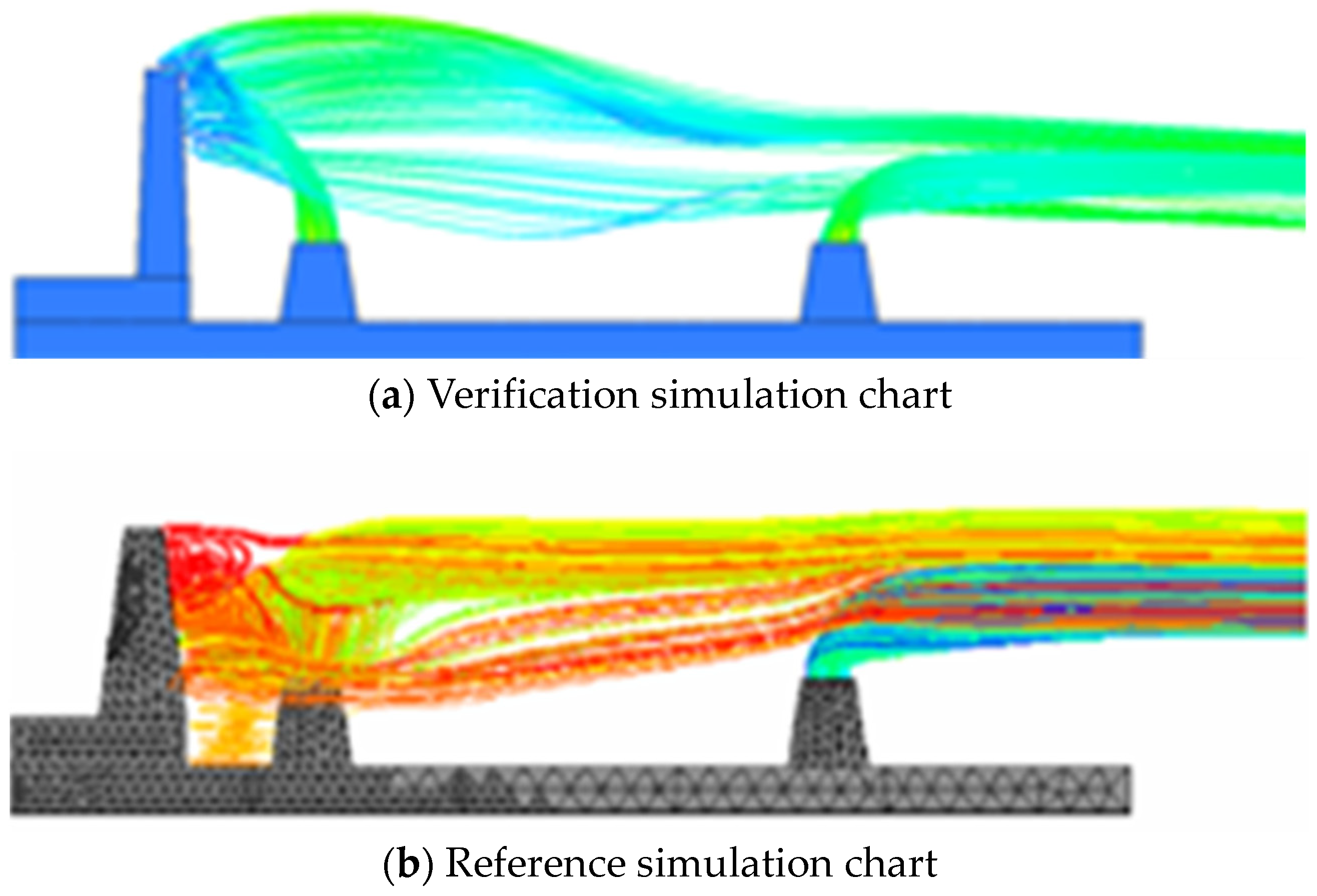
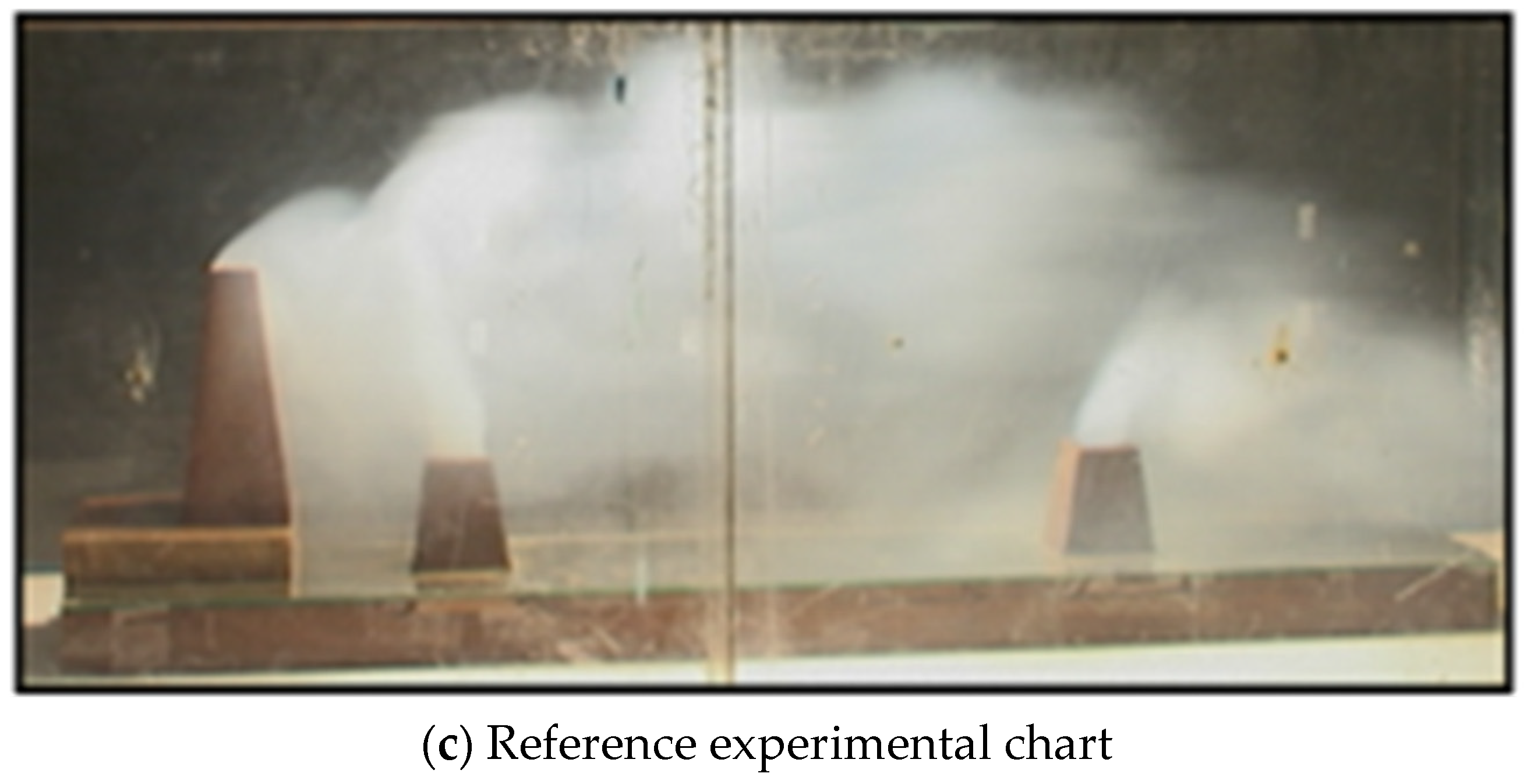
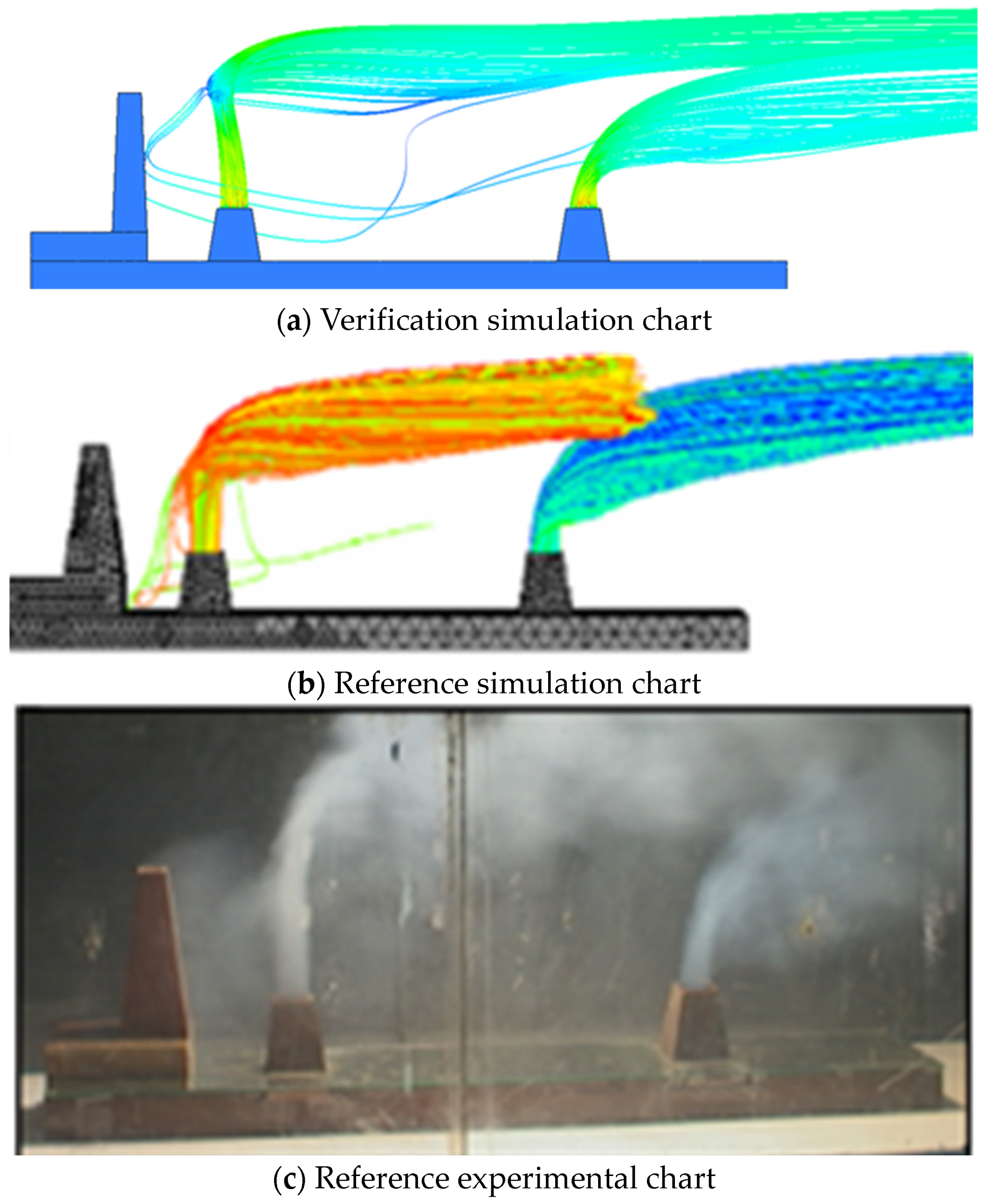
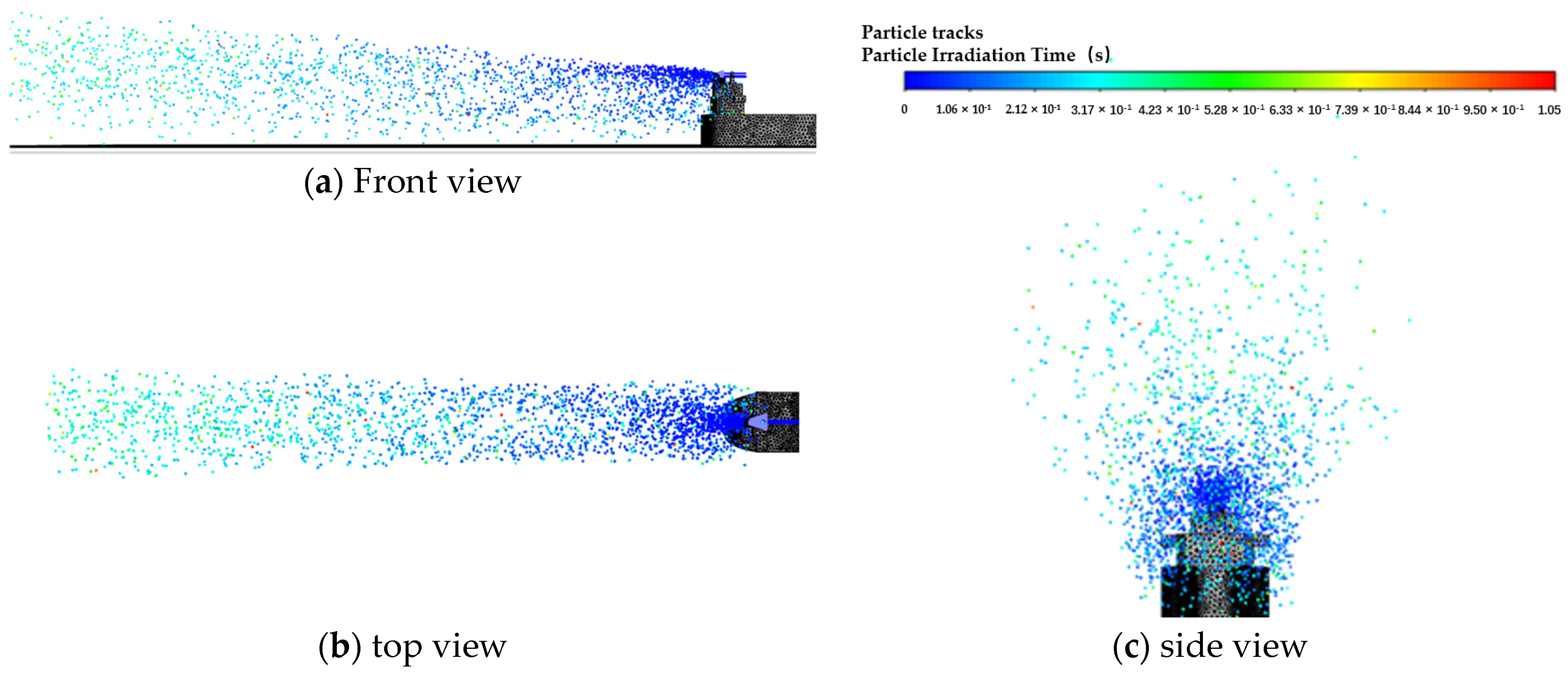

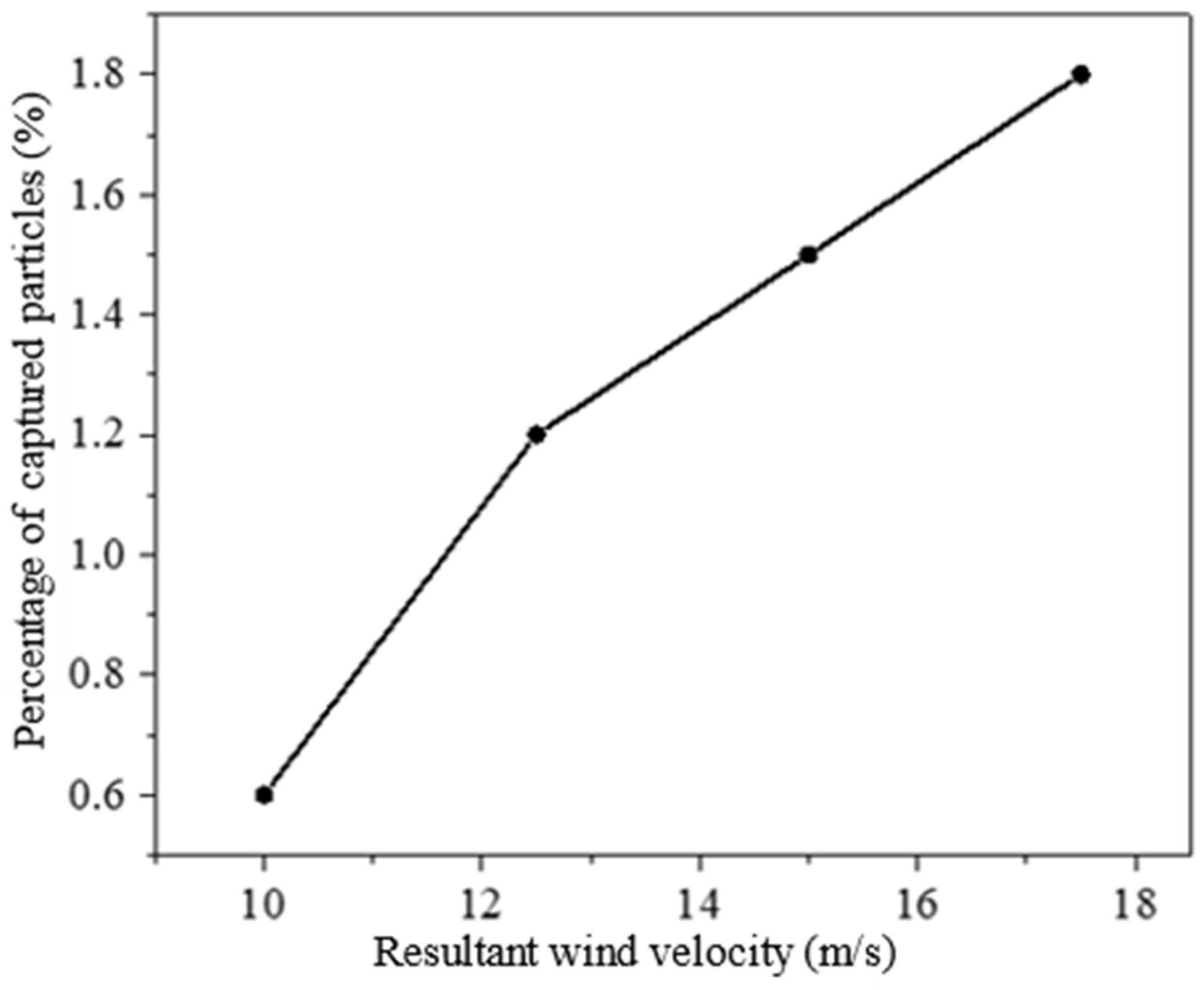
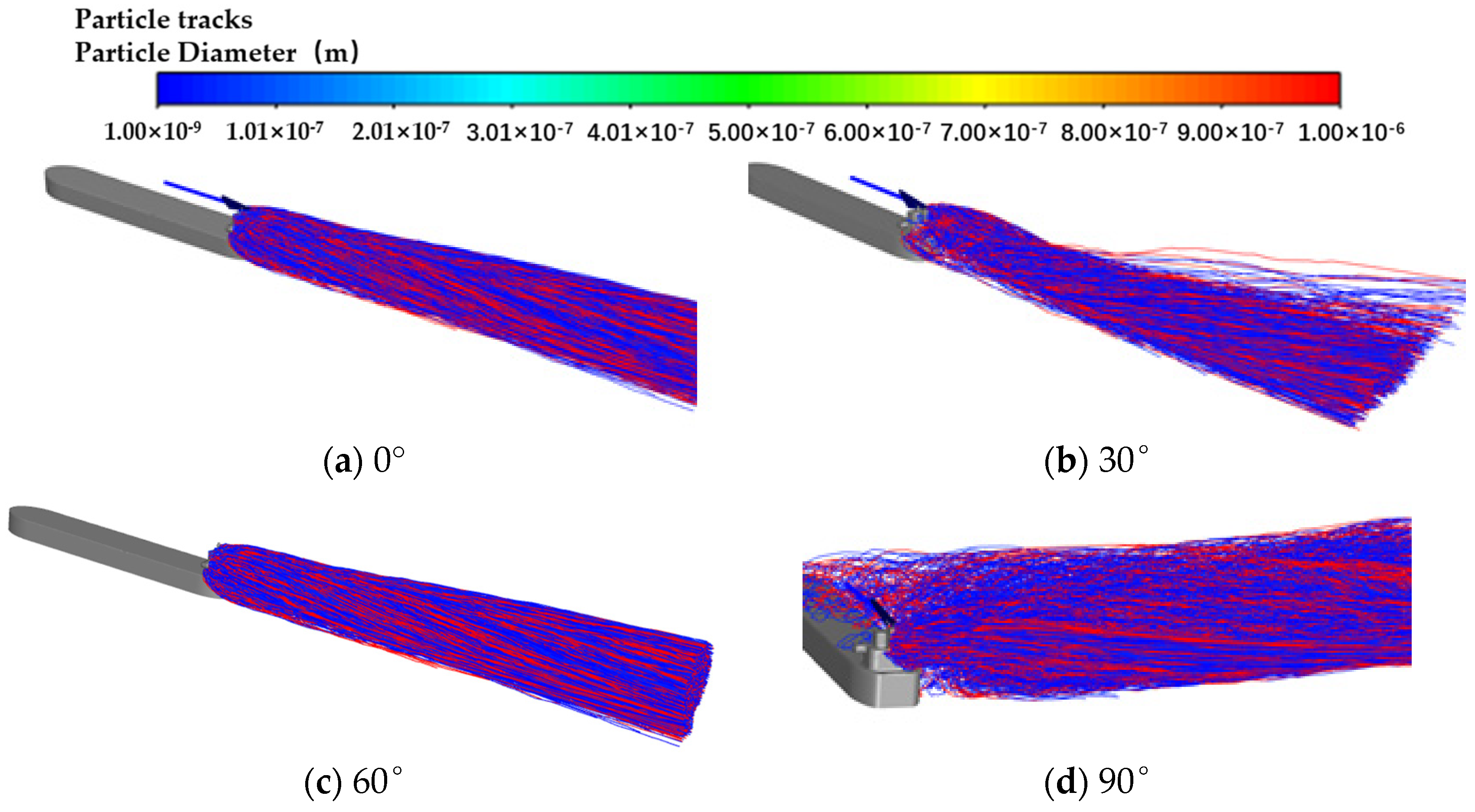
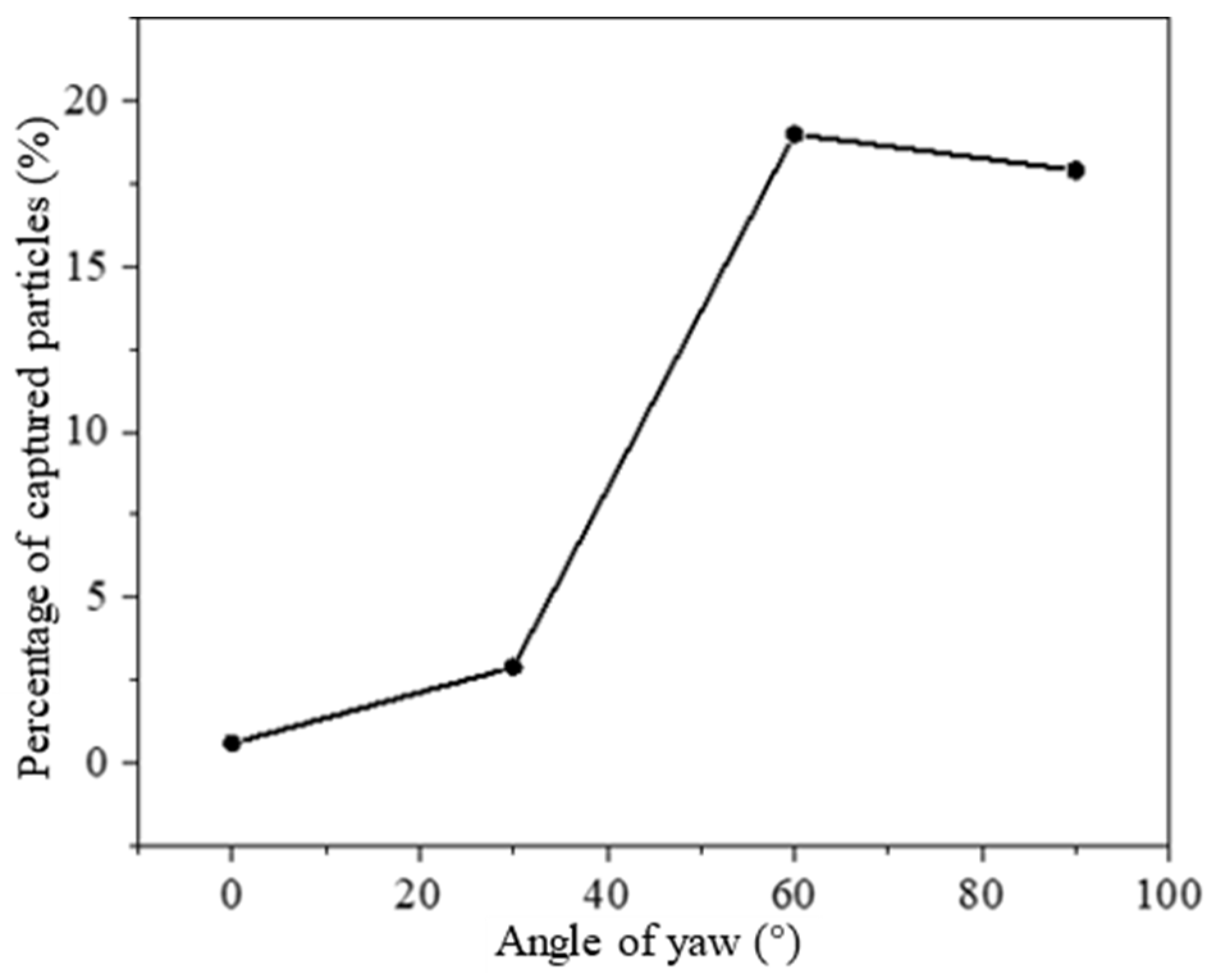
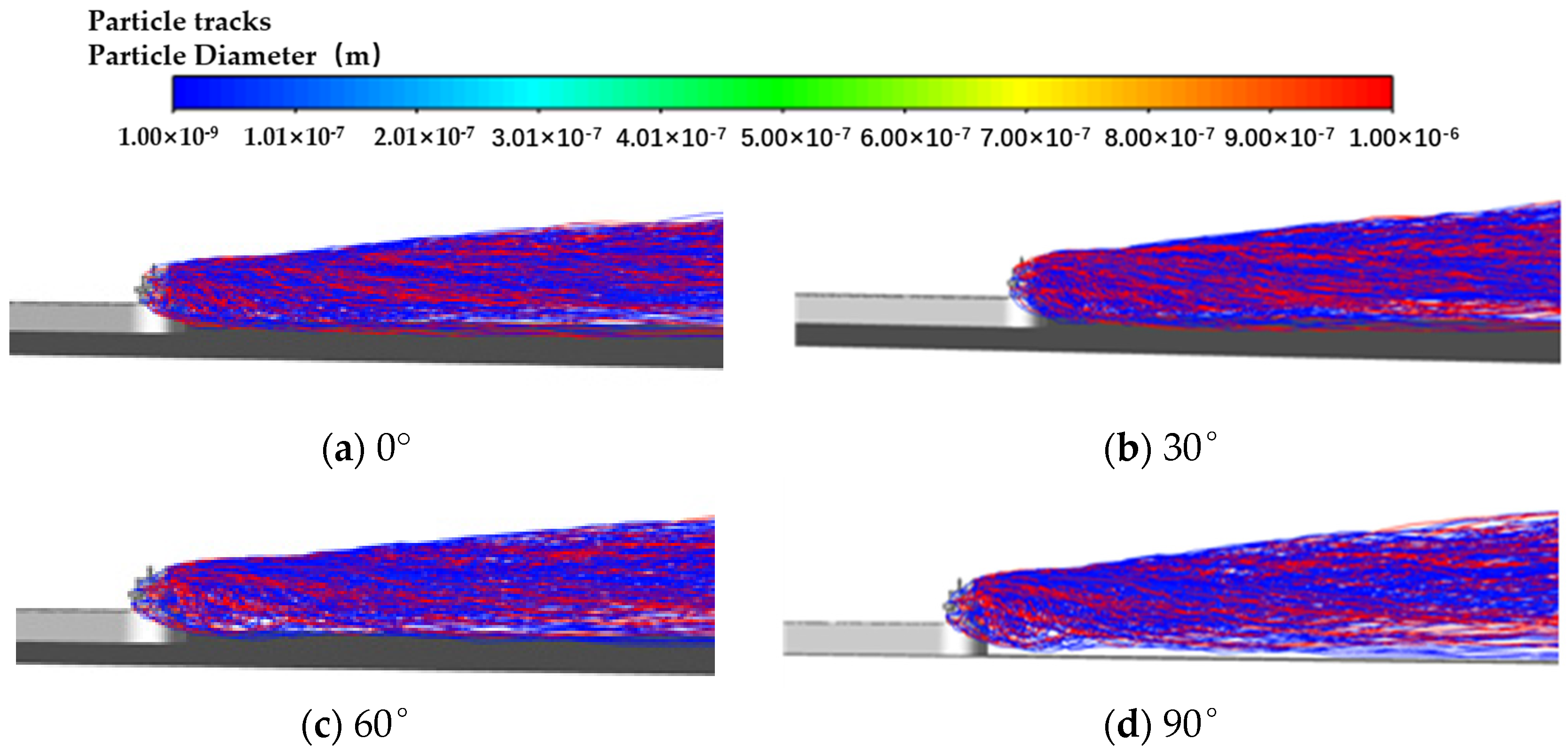
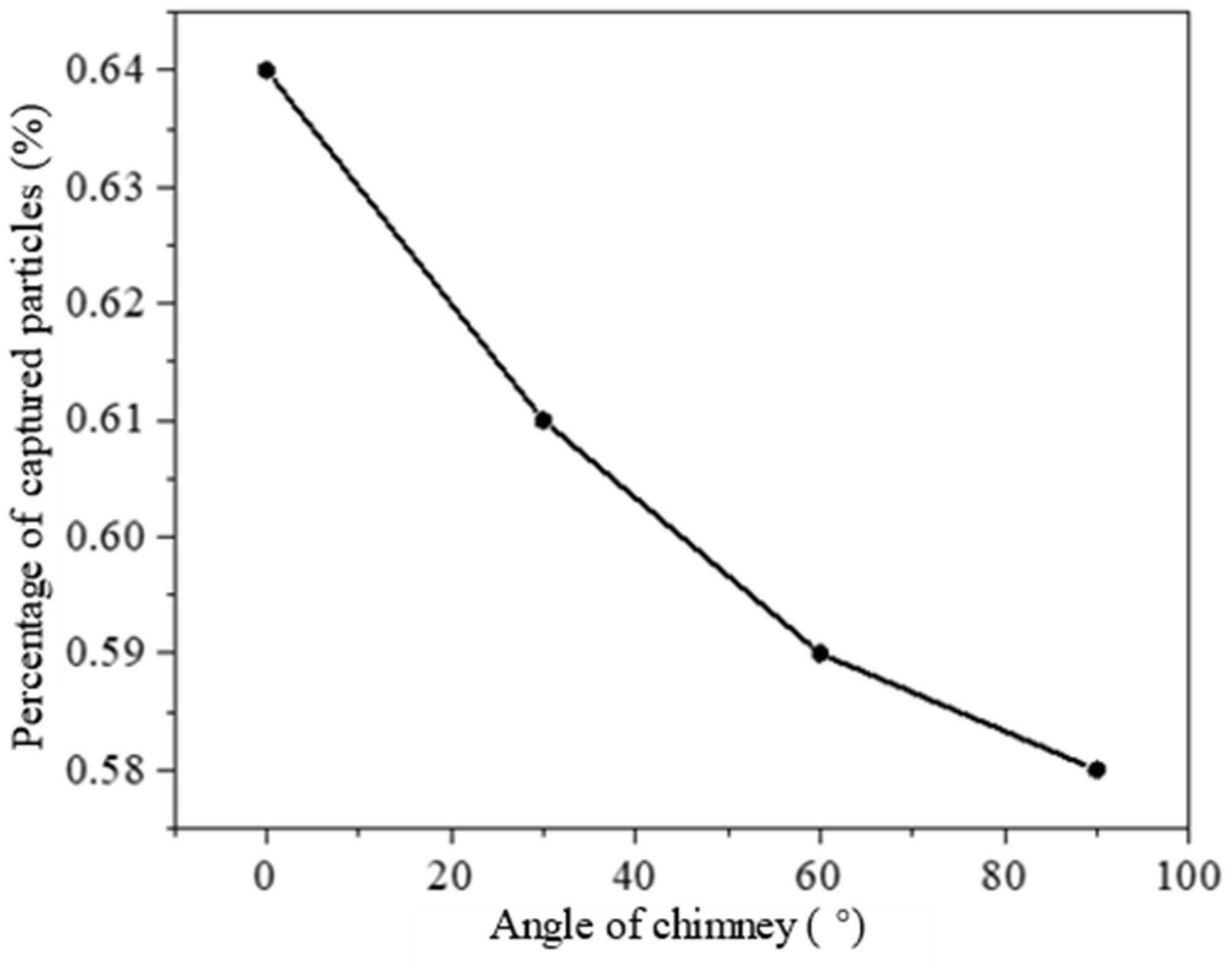
| Tonnage of Ship DWT (t) | Design Ship Size (m) | |||
|---|---|---|---|---|
| Length | Breadth | Depth | Load Draught | |
| 15,000 (12,501~17,500) | 153 | 23 | 12.9 | 9.4 |
| Air Velocity | Air Temperature | Exhaust Velocity | Exhaust Temperature | Particle Velocity | Particle Mass Flow | Particle Ejection Temperature |
|---|---|---|---|---|---|---|
| 10 m/s | 268 K | 10 m/s | 373 K | 10 m/s | 0.05 kg/s | 373 K |
| Case Name | Case 1 | Case 2 | Case 3 | Case 4 |
|---|---|---|---|---|
| Synthetic wind speed | 10 m/s | 12.5 m/s | 15 m/s | 17.5 m/s |
| Case Name | Case 1 | Case 2 | Case 3 | Case 4 |
|---|---|---|---|---|
| Yaw angle | 0° | 30° | 60° | 90° |
| Case Name | Case 1 | Case 2 | Case 3 | Case 4 |
|---|---|---|---|---|
| Chimney angle | 0° | 30° | 60° | 90° |
Disclaimer/Publisher’s Note: The statements, opinions and data contained in all publications are solely those of the individual author(s) and contributor(s) and not of MDPI and/or the editor(s). MDPI and/or the editor(s) disclaim responsibility for any injury to people or property resulting from any ideas, methods, instructions or products referred to in the content. |
© 2024 by the authors. Licensee MDPI, Basel, Switzerland. This article is an open access article distributed under the terms and conditions of the Creative Commons Attribution (CC BY) license (https://creativecommons.org/licenses/by/4.0/).
Share and Cite
Zhu, Y.; Wan, Q.; Hou, Q.; Feng, Y.; Yu, J.; Shi, J.; Xia, C. Analysis of Diffusion Characteristics and Influencing Factors of Particulate Matter in Ship Exhaust Plume in Arctic Environment Based on CFD. Atmosphere 2024, 15, 580. https://doi.org/10.3390/atmos15050580
Zhu Y, Wan Q, Hou Q, Feng Y, Yu J, Shi J, Xia C. Analysis of Diffusion Characteristics and Influencing Factors of Particulate Matter in Ship Exhaust Plume in Arctic Environment Based on CFD. Atmosphere. 2024; 15(5):580. https://doi.org/10.3390/atmos15050580
Chicago/Turabian StyleZhu, Yuanqing, Qiqi Wan, Qichen Hou, Yongming Feng, Jia Yu, Jie Shi, and Chong Xia. 2024. "Analysis of Diffusion Characteristics and Influencing Factors of Particulate Matter in Ship Exhaust Plume in Arctic Environment Based on CFD" Atmosphere 15, no. 5: 580. https://doi.org/10.3390/atmos15050580






